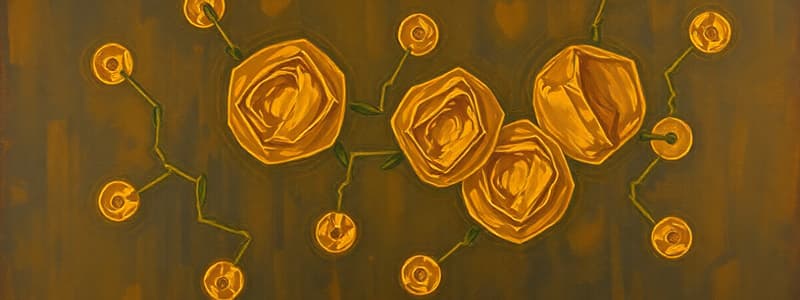Podcast
Questions and Answers
The product formed in the halogenation process is called a ______.
The product formed in the halogenation process is called a ______.
halohydrin
Oxymercuration involves a catalyst such as ______ which forms a complex with the π bond of the alkene.
Oxymercuration involves a catalyst such as ______ which forms a complex with the π bond of the alkene.
Hg(OAc)₂
In hydroboration-oxidation, the -OH group adds to the ______ substituted carbon.
In hydroboration-oxidation, the -OH group adds to the ______ substituted carbon.
less
The addition of H₂O to an alkene is typically catalyzed by an acid such as ______.
The addition of H₂O to an alkene is typically catalyzed by an acid such as ______.
When using alcohol instead of water in hydration reactions, the product formed is an ______.
When using alcohol instead of water in hydration reactions, the product formed is an ______.
The addition of X₂ to an alkene does not proceed through a C⊕ intermediate, resulting in ______ stereochemistry.
The addition of X₂ to an alkene does not proceed through a C⊕ intermediate, resulting in ______ stereochemistry.
In the halohydrin formation, the reaction involves adding 'H-O-X' to an alkene alongside water, with water being the ______ nucleophile.
In the halohydrin formation, the reaction involves adding 'H-O-X' to an alkene alongside water, with water being the ______ nucleophile.
The addition of hydrogen in hydrogenation reactions requires a ______ catalyst for the process to occur.
The addition of hydrogen in hydrogenation reactions requires a ______ catalyst for the process to occur.
Hydration of alkenes is achieved using H₂O along with ______ and requires a certain solvent for the reaction.
Hydration of alkenes is achieved using H₂O along with ______ and requires a certain solvent for the reaction.
During the Simmons-Smith reaction, the addition of a carbene leads to the formation of a ______ structure.
During the Simmons-Smith reaction, the addition of a carbene leads to the formation of a ______ structure.
Flashcards
Halogenation of alkenes
Halogenation of alkenes
Addition of X2 (Cl2, Br2, I2) to an alkene creating a vicinal dihalide. The reaction proceeds via a halonium ion intermediate (e.g., bromonium ion), which is anti addition.
Halohydrin Formation
Halohydrin Formation
Addition of water and a halogen across a double bond, creating a vicinal halohydrin where the halogen and hydroxyl are on adjacent carbons.
Hydroxylation of Alkenes (syn)
Hydroxylation of Alkenes (syn)
Addition of two hydroxyl groups across a double bond, producing vicinal diols. Different reagents/steps will yield cis or trans diols.
Epoxidation of Alkenes
Epoxidation of Alkenes
Signup and view all the flashcards
Ozonolysis of Alkenes
Ozonolysis of Alkenes
Signup and view all the flashcards
Halohydrin formation
Halohydrin formation
Signup and view all the flashcards
Markovnikov's rule in hydration
Markovnikov's rule in hydration
Signup and view all the flashcards
Oxymercuration
Oxymercuration
Signup and view all the flashcards
Hydroboration-Oxidation
Hydroboration-Oxidation
Signup and view all the flashcards
Acid-catalyzed hydration
Acid-catalyzed hydration
Signup and view all the flashcards
Study Notes
Alkenes Reactions and Synthesis
- Addition of H₂ to an alkene: Uses Pd/C catalyst.
- Addition of HX to an alkene: Uses HBr, HCl, or HI.
- Addition of X₂ to an alkene: Uses Br₂, Cl₂, or I₂. Results in vicinal dibromides (anti addition).
- Halohydrins from alkenes: Uses Br₂/H₂O, Cl₂/H₂O, or NBS/DMSO/H₂O. Produces alcohols with halogens at adjacent carbons (anti addition).
- Hydration of alkenes: Uses H₂O, Hg(OAc)₂, THF, then NaBH₄. This can be catalyzed by other acids. Markovnikov addition of OH.
- Hydroboration-Oxidation of alkenes: Uses BH₃ and then H₂O₂, OH⁻. Produces alcohols with OH on the less substituted carbon (anti-Markovnikov).
- Hydrogenation of alkenes: Uses H₂ and Pd/C catalyst; Syn addition of H₂.
- Epoxidation of alkenes: Uses MCPBA or other peroxy acid. Forms an epoxide (cyclic ether ring).
- Epoxide formation by treating a halohydrin with base: Acid-catalyzed hydrolysis of epoxide to form trans-1,2-diol.
- Preparation of a cis-1,2-diol: Uses OsO₄, pyridine, then NaHSO₃, or other reagents.
- Preparation of trans-1,2-diol: via acid-catalyzed hydrolysis of epoxide.
- Ozonolysis of alkenes: Uses O₃ followed by a reductive workup. Breaks the carbon-carbon double bond; Forms carbonyl products.
- Oxidative cleavage of alkenes with KMnO₄: Breaks the carbon-carbon double bonds; Forms carboxylic acid and/or ketone products.
- Oxidative cleavage of 1,2-diols with HIO₄: Breaks the carbon-carbon bond between diol groups; Forms carbonyl products.
- Addition of dichlorocarbene to an alkene: Forms cyclopropanes.
- Simmons-Smith reaction: Adds a methylene (CH₂) group to an alkene; Produces cyclopropanes.
- Free radical polymerization of alkenes: Forms polymers.
- Addition of HBr to an alkene in the presence of peroxides: Produces anti-Markovnikov addition product.
Additional Notes
- Stereochemistry: Important to consider the stereochemical outcome of reactions, particularly when new chiral centers are formed.
- Reagents: Reagents and the conditions they're used with are key to the success of these reactions.
- Mechanisms: Knowing the mechanisms for specific reactions helps in predicting the product and understanding the steps/processes.
- Solvents: Solvents are important in many reactions and their role must be understood.
- Catalysts: Catalysts are also crucial and help in the success of reactions.
Other topics
- Halohydrins: Alcohols with halogen on adjacent carbons.
- Markovnikov's Rule: The rule for addition of HX/H₂O to alkenes (the hydrogen adds to the carbon with more hydrogens).
- Anti-Markovnikov's Rule: The rule for hydroboration-oxidation of alkenes (the opposite of Markovnikov's rule).
- Cis-1,2-diols: a diol with adjacent hydroxyl (-OH) groups positioned on the same side of the molecule.
- Trans-1,2-diols: a diol with adjacent hydroxyl (-OH) groups positioned on opposite sides of the molecule.
- Epoxide: Three membered ring cyclic ether.
Studying That Suits You
Use AI to generate personalized quizzes and flashcards to suit your learning preferences.
Related Documents
Description
Test your knowledge on various reactions and synthesis involving alkenes. This quiz covers key addition reactions, hydration, hydroboration-oxidation, and epoxidation mechanisms. Enhance your understanding of how alkenes interact with different reagents to form diverse products.




